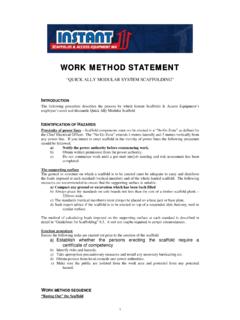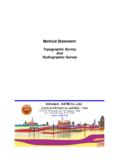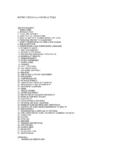Transcription of SAFE WORK METHOD FOR WORKING AT HEIGHTS AND LADDER USE
1 SAFE work METHOD FOR WORKING AT HEIGHTS AND LADDER USE 1 THIS FORM MUST BE CONSIDERED PRIOR TO ANY WORKS COMMENCING IN AN AREA. 2 THIS FORM IS TO BE KEPT IN THE AREA WHERE THE work TASK IS BEING UNDERTAKEN. 3 ALL SECTIONS OF THIS FORM MUST BE CONSIDERED 4 ALL EMPLOYEES WHO MAY USE LADDERS MUST BE MADE AWARE OF THIS FORM AND ITS REQUIREMENTS This work METHOD statement is to be read in conjunction with associated guidelines, work procedures, hazard identification, risk assessments and Safe work METHOD associated personnel are to be suitably instructed and trained and comfortable in relation to WORKING at height and will have been trained in this & associated work procedures. All works, tools, equipment and plant are to be used in accordance with industry standards, company policy, codes of practice, legislation & regulation. Hazard/Risk type: Fall from height death, serious injury, sprains, strains, fractures, abrasions, contusions, lacerations, open wounds and dislocations.
2 11. Issues to be considered when WORKING at height . 1 Prior to using a LADDER to work at HEIGHTS the hierarchy of control needs to be considered and implemented. ( See supporting guidelines ) 2 Hierarchy of Control 1a) Elimination 2b) Substitution 3c) Engineering 4d) Administration 5e) PPE (personal protective equipment) 3 Can the task be performed in a better manner? ie; 1a) Can the work be performed on the ground? 2b) Can the work be performed from a fixed scaffold? 3c) Can an Elevated work Platform [EWP] be used? 4d) Can a mobile scaffold be used? 5e) Can a work platform (chariot) be used? If it is determined that ladders are the most suitable and practicable option available to be used, then only after assessment of the practicability of other methods the following shall apply. 2. Objectives 1 Generally ladders should be the last METHOD of controlling work at HEIGHTS , however regard as to the practicability of controlling work at HEIGHTS needs to be incorporated into the selected work METHOD .
3 2 It is anticipated that work off ladders will be generally carried out at HEIGHTS of no more than metres ( this is the height to the feet supported on the LADDER ). work at greater than this will need to have additional documented risk assessments and Safe work METHOD Statements, developed and implemented. 1 It is also anticipated that ladders may be selected for use when clear floor spaces areunavailable and floor load limits restrict the use of EWP s, mobile or fixed scaffolds or other means. 2 It is anticipated that ladders may be selected for use when physical space restricts the use of other methods to control the risk of WORKING at HEIGHTS . 3 It is anticipated that the use of power tools will be restricted to the cordless type. 4 It is anticipated that the tasks where ladders are to be used will be of a light duty nature. 5 Ladders will not be used within 3 metres of an unprotected edge or perimeter of the building.
4 6 If in doubt about using a LADDER ask the Site Safety Co-ordinator or a member of the Safety Committee for assistance. 13. People Using Ladders/Step Ladders Should Not:- When using a LADDER the following activities should not be conducted; 1a) work from a LADDER while using personal protective clothing and equipment thatrestricts vision welding helmet; 2b) work from a LADDER to perform Hot Works without a documented risk assessment & Safe work METHOD Statement welding; 3c) work from a LADDER using equipment primarily designed to be used with two hands; this includes tasks that do not allow for three points of contact,ie,both feet on the rung and one hand free for balance and ) Stand less than 900mm from the top of a single LADDER or less than 3 treads from the top when using a stepladder; 5e) work from a LADDER when facing away from the LADDER .
5 6f) work from a LADDER that is not secured top & bottom (a second person may haveto foot or hold the LADDER until it is secured); (Note: stepladders may require a second person to 'foot' the LADDER for added stability) 7g) work from a stepladder that is not fully spread and spreaders locked; 8h) Use of a LADDER that does not conform to Australian Standards; 9i) Use of a LADDER that does not have at least a 120kg SWL and rated as industrial; 10j) Use of a LADDER that is damaged or poorly maintained; 11k) Use of a LADDER that has been repaired in a manner inconsistent with the Manufacturer or Nominated Service Agent s standards; 12l) work from a LADDER using electrical equipment that may cause additional risk such as entanglement, trip & tipping hazards; 13m) work from a LADDER where over-reaching is required (the belt buckle must always be within the stiles of the LADDER ); 14n) Use of a LADDER where the correct angle of inclination (1 in 4) can not be achieved; 15o) Use of a LADDER on a slippery surface; 16p) work on a LADDER over other persons; 17q) work on a LADDER with more than one person on the LADDER ; 18r) work on a LADDER set up on a scaffold, EWP or stacked materials to gain additional height ; 19s) work on a LADDER in an access/egress area without appropriate control methods ; 20t) work on a LADDER within the arc of a swinging door without appropriate control methods ; Further guidance and definition should be sought from Worksafe Guidance Note Prevention of Falls in Construction, Selection and safe use of portable ladders.
6 (2013) and the Codes of Compliance for the Prevention of Falls in Housing / General Construction Remember - If in doubt ask. Area: _____ Signature: _____ Date: _____ Names: _____







